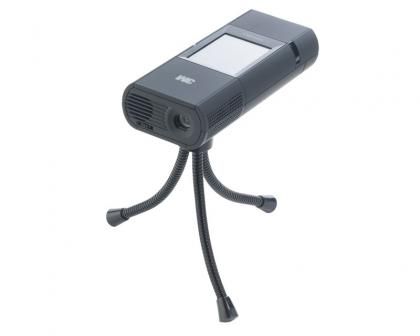The MP180 is a highly versatile office projector. It's a short-throw model, which means it can project large images even when very close to a surface, and it can be hooked up to a source via VGA or component inputs (using an adaptor), display files from internal memory or a microSD memory card or copy them to internal memory over Bluetooth, and even browse the web over Wi-Fi.
Built-in office document and PDF support means you can read documents, spreadsheets and presentations directly from a memory card, and there's also support for MPEG4 and H.264 movies and MP3, AMR and AAC audio files. BMP and JPEG image files can also be displayed. A resistive touchscreen interface lets you browse files, access settings and even browse the web, using the touchscreen to control a mouse and an on-screen keyboard. It's extremely fiddly, but if it means not having to carry a laptop around with you then it may be worth it.

Pico projectors use LCOS (Liquid Crystal On Silicon) chips. These are like a mirror with a liquid crystal layer. An LED light source is used, reducing power consumption and meaning the lamp lasts a long time (the LED lamp in the MP180 has an estimated life of over 20,000 hours). The upshot is a tiny projector that can project an 80in-diagonal picture at about two-and-a-half metres, with a built-in battery that lasts for about two hours. The MP180's versatility makes it ideal for travelling business people, but it's not without its flaws.
For a start, the MP180 only produces 30 lumens of brightness, so unlike normal business projectors designed for use under harsh office lighting, the MP180 should either be used in a darkened room or at very short range. The second limitation is a physical one: the desk stand that comes in the box is a three-legged tripod stand with flexible legs, which screws into a standard mount on the MP180's underside. The legs don't keep their shape well and so provide a rather shaky foundation; it would be wise to either invest in a proper tripod or a Joby GorillaPod.
